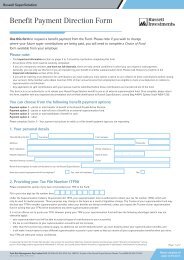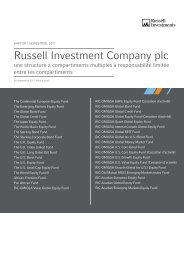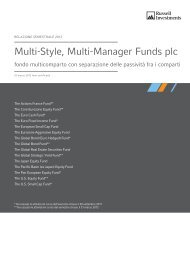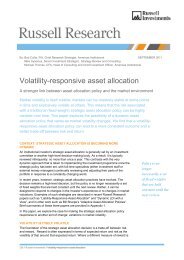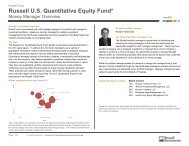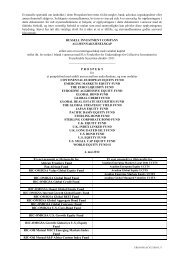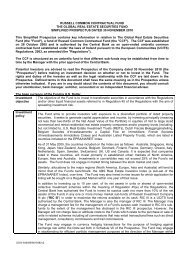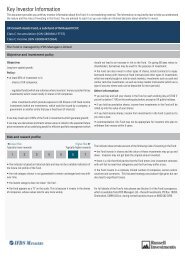Implementing LDI with swaptions - Russell Investments
Implementing LDI with swaptions - Russell Investments
Implementing LDI with swaptions - Russell Investments
You also want an ePaper? Increase the reach of your titles
YUMPU automatically turns print PDFs into web optimized ePapers that Google loves.
RUSSELL INVESTMENTS<br />
CLIENT FOCUS (continued)<br />
Asset allocation is not about risk alone,<br />
but about the trade-off between risk and<br />
expected return. If the rewards for taking<br />
risk are highest at the times of high market<br />
volatility, then the reduction in volatility<br />
shown above would come at too high a<br />
price: a drop in returns that more than wipes<br />
out the risk benefit. Here, too, the strategy<br />
stands up well: there was no return penalty<br />
over the period analyzed; the volatilityresponsive<br />
strategy delivered an average 40<br />
basis points higher return after accounting<br />
for trading costs.<br />
The full results are summarized in the table<br />
below, which compares the return pattern of<br />
the volatility-responsive strategy to that of a<br />
fixed 50/50 mix.<br />
Let us consider each of these statistics in turn.<br />
Annualized return: Even allowing for the<br />
cost of trading, the volatility-responsive<br />
strategy delivered a return over the full<br />
period that not only matched but beat that<br />
of the fixed mix. Note, however, that this can<br />
be episodic: there are periods of reduced<br />
return as well as periods of enhanced return.<br />
Annualized standard deviation: For<br />
the reasons described in the previous<br />
Communiqué article, we would expect the<br />
volatility-responsive strategy to deliver a<br />
more stable return stream than the fixed mix,<br />
and this was indeed the case. Note that not<br />
only is the standard deviation of returns over<br />
the full period lower, but the variability of the<br />
standard deviation over short periods is also<br />
materially lower, as shown in Exhibit 2.<br />
5%ile monthly return: Roughly one in<br />
20 of the monthly returns were –3.05%<br />
or worse under the volatility-responsive<br />
strategy, while roughly one in 30 were<br />
–3.41% or worse under the fixed mix. Thus,<br />
using this as a definition of a bad-case<br />
scenario, the volatility-responsive strategy<br />
fares slightly better, mitigating downside risk.<br />
Worst monthly return: A more extreme<br />
bad-case scenario is provided by a look<br />
at the lowest monthly return. For the<br />
volatility-responsive strategy, this would<br />
have occurred in October 1987, when the<br />
portfolio value fell by 9.44%. (As a point<br />
of comparison, in that month the fixed-mix<br />
value fell by 9.43%.) The worst month for<br />
the fixed mix was October 2008, when<br />
it fell by 10.05%. (By comparison, the<br />
volatility-responsive strategy fell by 5.44%<br />
that month.)<br />
Worst three-month return: For the<br />
volatility-responsive strategy, this was a<br />
September through November 1987 decline<br />
of 12.16%. (As a point of comparison, over<br />
that same period, the 50/50 fixed mix<br />
declined by 14.37%.) The worst three-month<br />
return for the fixed mix, a loss of 16.86%,<br />
occurred in September through November<br />
2008. (By comparison, the volatilityresponsive<br />
strategy would have declined by<br />
8.77% over that three-month period.)<br />
In summary, then, each of the measures<br />
points to the volatility-responsive strategy<br />
Exhibit 1: Summary statistics of volatility-responsive strategy, April 1979–June 2011<br />
Fixed mix (50% equity) Volatility-responsive strategy<br />
Annualized return 10.28% 10.68%<br />
Annualized standard deviation 8.99% 8.43%<br />
5%ile monthly return –3.41% –3.05%<br />
Worst monthly return –10.05% –9.44%<br />
Worst three-month return –16.86% –12.16%<br />
Indexes are unmanaged and cannot be invested in directly.<br />
Past performance is not indicative of future results.<br />
p / 9



